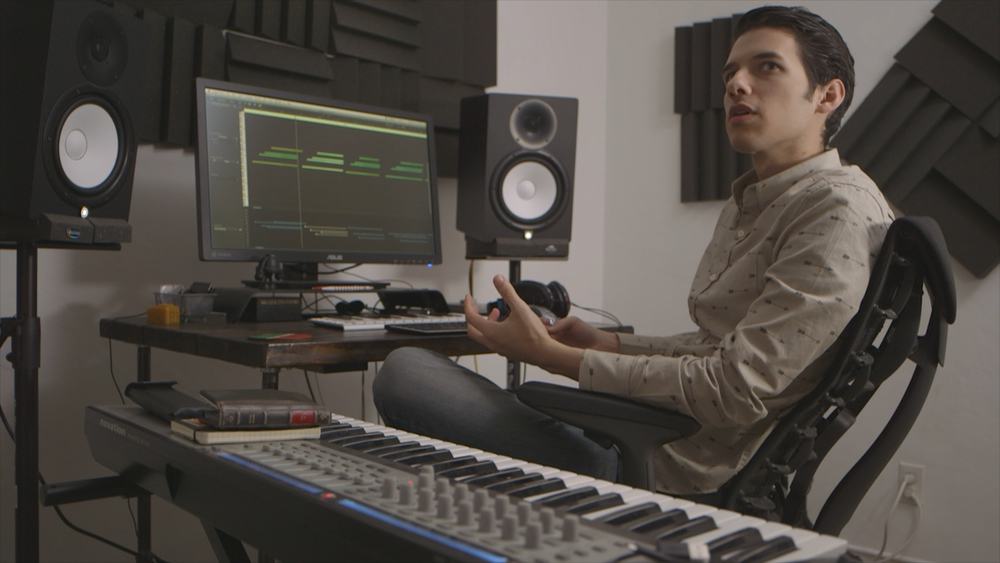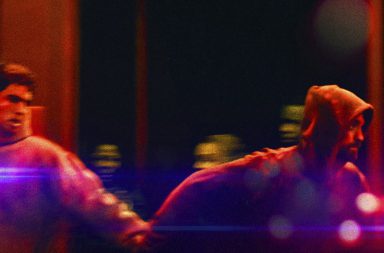Rich Vreeland, aka Disasterpeace, is a multi-talented artist: a musician, a producer, a composer, the young artist has an incredible portfolio that spans over a multitude of genres and mediums. In addition to producing his own music, Vreeland composed the terrific chiptunesque score for the smash hit game Fez and the atmospheric horror sensation, It Follows. This score (his very first incursion into the film scoring world) received unanimous praise, cementing his role as a bright star in the film composition industry. Vreeland’s past work is predominately centred around video game music, most notably Mini Metro, Reigns and the recently released Hyper Light Drifter.
Born into a musical family in Staten Island, NY, Vreeland was continually exposed to music, claiming that “[w]hen [he] was little, [he] used to love using [his] hands as percussion, slapping tables, [his] stomach, and clicking out rhythms on [his] teeth.” We were lucky enough to chat to this multifaceted artist and talk about his musical style, his previous work and the contrast between media which he navigates so fluidly.

Rich Vreeland (Screenshot from the documentary Outerlands: Season 1—Short—Rich Vreeland is Disasterpeace)
Score It Magazine: To begin, let’s talk about your score for the indie puzzle-platform video game Fez. You left some portions of your score without music. How do you deal with and value silence in your work?
Rich Vreeland: I value silence a whole lot. It lends a lot of contrast to the notes you actually do write, and we used silence as a way to give the player a chance to regather themselves in places, or to simply give an environment a different sort of feel. Sometimes just having ambience can allow you to melt into an environment in a way that music might obfuscate, or draw you away from.
In an article for Kotaku, you mentioned that some of your compositions for Fez “have very fluid tempos, that ebb, flow and breathe along with the player”. This statement has strong reference to natural images. Are you touch with and inspired by natural surrounds as a composer?
Absolutely. There are many examples of this sort of thing in the Fez soundtrack. The track ‘Fear’ is comprised of elements composed for a rainy graveyard, namely large chords and long, quiet trickly arpeggios. These two elements are meant to represent thunder and rain, respectively, and the timing in playback of these is somewhat random too, to mimic the unpredictable nature of thunder. Another example is ‘Formations’, which is used in a series of caves, and uses a similar trickling technique to mimic the sound of water droplets, falling from a cave ceiling.
Let’s discuss your compositions for the critically acclaimed horror film It Follows (David Robert Mitchell, 2015), which marked the start of your film score career. How did you find this transition from composing for a game to composing for a film?
I actually think the act of scoring a film is similar in some ways to the act of playing a game you’re working on: either listening back to the music you’ve already written as a means to improve it, or considering what to write and where. It’s in that moment-to-moment experience where film music really comes out, and the benefit of scoring a film is that the process tends to be more immediate than in games. In games, you often have to suspend disbelief a tad while you write the music, imagining how it will integrate and react within the game’s possibility space. When scoring a film of course you can put the movie right there in your DAW session.
I had already scored a fair amount of linear content, whether it be short films, trailers or linear sequences in games, so I came in with understanding of what it would more or less be like. That said, I think working at the magnitude of a feature required me to get very close to the moment to moment, and that’s probably even more true on the current film I’m scoring. It Follows took me a month. I’ve been working on this one for nearly a year.
The editor used pre-existing music of yours in the temp score for It Follows. Did you find it difficult distance yourself from your previous work in this case?
Yes, absolutely. I had never been in a situation before where something had been temped or was referencing my own music, and it was difficult for me at times to try and recapture what was working for the director and editor about these tunes while managing something new. I think for the most part we succeeded and I found that process challenging and enlightening. I’ve come to appreciate the use of temp score in my own workflow, especially when I’m delving into unknown territory. I think temp score is more or less inert—it’s more about what you do with them. I seek to be influenced by them without being tied to them like a crutch. I think the temp experience has allowed me to better deconstruct unfamiliar musical genres, and even deconstruct the music I had previously written.
Going back to the idea of silence in your scores: during some of the film’s key and most intense moments, there is no music at all. This is evident in the chloroform-attack scene in the car, for instance. This silence is extremely effective in those places, adding a disconcerting impact and a realist edge. Can you tell us more about your choice behind this technique?
This was more the choice of Julio Perez (editor) and David Robert Mitchell (director). The temp score had no music here and it never seemed to me like it needed it. I think you are right in that we all like using silence sometimes to mix it up or to add a certain kind of impact. I will say that towards the end of the process David added some of the low frequency rumble I had created to this scene, and we ended up using it throughout the movie as a sort of motif of dread.
Whenever the demon approaches the protagonist, a slow, rhythmic drumming commences in the score. This perfectly manifests the chilling presence of this monster. What was your creative process in representing the demon, musically
The temp had a lot of pulsing in it and I felt like a rhythmic motif would be a great way to consistently capture this feeling of inevitable dread. The consistency of the drum part identifies the ‘It’ and generally, there are lots of wild and crazy sounds swarming around it, almost like some kind of possessed aura.
In the tracks ‘Title’ and ‘Jay’, the score sometimes mixes high-tone melodies that are loyal to the chiptune genre, with very dark and long synth layers, which are more associated with horror films. How did you manage to construct such an original and effective blend?
I can say it was never my intention to inject any sort of chipmusic style into the movie, but it probably wiggled its way in there by sheer osmosis. Also, these two tracks were originally temped with tunes from Fez, so they ended up retaining some of their timbral qualities.
In 2016, you composed for Mud Water, a piece of theatre. Was that a different kind of challenge for you as a predominantly electronic music artist?
I’ve typically been drawn to different formats as a way to grow as an artist, and it was a very unique experience writing music for Mud Water. Instead of working with the dancers directly and thinking about choreography, the project director wanted me to riff on floral imagery and ideas about shared human experience. It was fun to think and work that way but also very demanding as it often can be when working with an auteur.
Do you draw upon major influence from other film composers or game composers?
Absolutely. Yasunori Mitsuda and Koji Kondo are towering influences over my work. ‘Title’ from It Follows is directly influenced by the melodic sensibility of Ennio Morricone. I’m write a score right now that is heavily influenced by the work of Bernard Herrmann.
Can you tell us about your forthcoming projects?
I‘ve been working on an orchestral/hybrid score for a noir film called Under the Silver Lake for the past year with the director of It Follows, David Robert Mitchell. We hope to be finished soon!
Have a listen to the nail-biting It Follows soundtrack below.
Interview prepared, conducted and transcribed by Amalia Morris and Sylvain Pinot.



